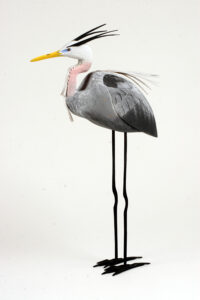Ivy Billiot
A member of the United Houma Nation, Ivy Billiot is a self-taught woodcarver who creates colorful, meticulously rendered fish, birds, reptiles, and other wildlife out of native Louisiana woods.

Courtesy of Nick Spitzer
Great Blue Heron. Billiot, Ivy (Artist)
A member of the United Houma Nation, Ivy Billiot is a self-taught woodcarver who creates colorful, meticulously rendered fish, birds, reptiles, and other wildlife out of native Louisiana woods. Honing his skills in a community of master craftsmen and working in a traditional American Indian medium, Billiot employs modern flourishes to create lively, often whimsical forms. His representations of indigenous species speak to the state’s diverse terrestrial and marine fauna and are held in public and private collections across the southeast.
Billiot was born in 1945 in Grand Cailou, Louisiana, to Alfreda Molinere Billiot and Cyril Joseph Billiot. One of three children, Billiot learned about traditional Houma culture as well as the state’s indigenous animals from his mother. His artistic interests, however, derived largely from his father, an accomplished craftsman. The senior Billiot executed unpainted cypress woodcarvings of birds, crawfish, alligators, and crabs, but he was most highly regarded for his split-cypress baskets, an endangered tribal art form.
Growing up in the town of Houma, where he still lives today, Ivy Billiot began carving around the age of five. His earliest creations were miniature pirogues, the small flat-bottomed boats ubiquitous to the region’s shallow waterways. By his teen years, Billiot had progressed to building larger works such as model seaplanes. He continued to carve and craft wooden objects even as he worked for Terrebonne Parish, clearing bayou channels and other drainage ways. Years of felling and cutting trees allowed him to become a nimble chainsaw operator, a skill that would serve him well when he began working as a full-time artist in the 1980s.
Billiot uses such mechanized equipment to rough out large segments of wood, primarily water tupelo. The precise paring and incising, the most time-intensive part of the artistic process, is done manually with a knife and other small hand tools. His earliest pieces remained unpainted like his father’s, but today he carefully applies hand-blended acrylic paints, often finished with a clear glaze topcoat. The detailed use of color—whether in the white-tipped feathers of a mockingbird or the eyespots appearing on the tail of a Louisiana redfish—gives his creations a lifelike realism. Carefully placed synthetic eyes and meticulously rendered tusks, gills, and decorative plumage further enhance the verisimilitude.
Drawn from the imagination or the careful study of photographic images, most of Billiot’s creations are modest in scale. Such pieces include life-sized songbirds and gulf coast fish, as well as miniature panthers, buffalo, and black bears. On occasion, he carves much larger works, such as towering blue herons and open-mouthed alligators extending several feet. While wildlife, both indigenous and exotic, dominates his current artistic output, Billiot once also carved blowguns, historically used by the Houma people for hunting small game and birds. He mastered the form after an elder tribal craftsman, Antoine Billiot, ceased making them. Using the tube-like stem of elderberry plants, the younger Billiot embellished his works with feathers, leather, and depictions of animals.
Billiot appears regularly at the New Orleans Jazz & Heritage Festival’s Native American Village, as well as other fairs and cultural events throughout the region. He and his father, along with master basket weaver Marie Dean (1916-2010), were the featured artists in the 1999 exhibition Houma Indian Arts: Triptych. Billiot’s work is in the collection of the Louisiana State Museum, shown at art galleries in Louisiana, Texas, North Carolina, and sold at prominent folk art auctions.
